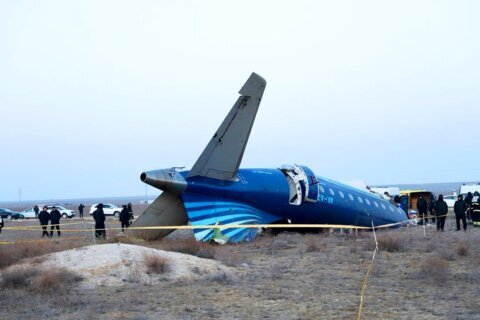BANGKOK (AP) — A new mutual-defense pact signed by Russian President Vladimir Putin and North Korean leader Kim Jong Un commits each country to come to the other’s aid if attacked.
Just what the threshold for such assistance would be is currently unclear — maybe deliberately so, to deter other countries from putting it to the test. Putin initially told Russian media that the partnership provides for “mutual assistance in the event of aggression against one of the parties,” while North Korea’s state-run Korean Central News Agency later reported that the pact’s Article 4 called for assistance “in the event that either of the parties is invaded and pushed into a state of war.”
If the pact is triggered, the countries’ obligations are also vague, with KCNA reporting that if one is attacked the other must deploy “all means at its disposal without delay” to provide “military and other assistance.”
Experts note that the language is almost identical to that of a previous mutual defense pact from 1961 between the Soviet Union and North Korea, which was never put to the test.
Such pacts are not uncommon and are rarely invoked, while often being touted as a means of deterring aggression, though the agreement between the two unpredictable and autocratic leaders of nuclear nations immediately raised concerns globally.
The United States has many similar treaty obligations with other Asian nations, not to mention through NATO’s Article 5 provision, which says that an attack on a member of the alliance is to be considered an attack against all of its members. The only time NATO’s Article 5 has been invoked has been to come to the defense of the U.S. after the Sept. 11, 2001, attacks.
Russia also has mutual defense pacts with several post-Soviet states through its Collective Security Treaty Organization alliance, including Belarus and Kazakhstan.
These are some other significant agreements in the region:
China-North Korea
China has only one mutual defense agreement, and it’s also with North Korea, formally known as the Democratic People’s Republic of Korea.
The pact was signed in 1961, eight years after the Korean War, which started after North Korea, supported by China and the Soviet Union, invaded South Korea, supported by a United Nations effort led by the United States.
Under the agreement, the two countries agreed that if one were attacked, the other would “immediately provide military and other assistance to the best of its ability.”
Marking the 62nd anniversary of the pact last year, China’s People’s Daily reported that “no matter how the international and regional situation changes, China and the DPRK have always trusted and supported each other in accordance with the spirit of the treaty.”
Since it was signed, however, there have been many incidents of violence between North and South Korea, but the agreement has never been invoked.
When North Korea fired artillery at a South Korean island in 2010, killing two marines and two civilians, South Korea returned fire and caused an unknown number of North Korean casualties. China reportedly warned North Korea at the time that it was not obligated to come to its aid if it instigated the aggression.
United States-Philippines
The U.S. has collective defense agreements with six countries in the Asia-Pacific region: South Korea, Japan, Australia, New Zealand, Thailand and the Philippines.
Recently it’s been the 1951 treaty with the Philippines that has been in focus, as China pursues sweeping claims in the South China Sea ever more aggressively, leading to physical confrontations with Philippine ships.
Three weeks ago, Philippine President Ferdinand Marcos Jr. told a defense forum in Singapore that if one of his citizens were killed by China, it would be “very, very close to what we define as an act of war,” giving rise to new fears that the tensions could spark a broader conflict between the U.S. and China.
Just this week, after at least eight Filipinos were injured in a scuffle as China’s coast guard tried to prevent them from delivering fresh supplies to a territorial outpost, the U.S. renewed its warning to Beijing that it was obligated to defend the Philippines.
U.S. Deputy Secretary of State Kurt Campbell told his Philippine counterpart that Washington’s treaty obligation “extends to armed attacks on Philippine armed forces, public vessels, or aircraft -– including those of its coast guard -– anywhere in the South China Sea,” according to the State Department.
In addition to its NATO obligations, the U.S. also has mutual defense agreements with multiple Central, South American and Caribbean nations under the 1947 Rio Treaty.
United States-Taiwan?
The U.S. does not have a mutual defense pact with Taiwan and adheres to a so-called One China policy, in which it recognizes only Beijing as the government of China but allows informal relations and defense ties with Taiwan.
China maintains that self-governing Taiwan is a part of its territory and has not ruled out taking the island by force if necessary.
The U.S. has left it intentionally vague how it would respond if Taiwan were to be invaded by China, pursuing a policy known as “strategic ambiguity.”
At the same time, U.S. President Joe Biden has said on several occasions that the U.S. would respond militarily if China invaded Taiwan.
U.S. Secretary of Defense Lloyd Austin said earlier this month, however, that war with China was neither imminent nor unavoidable, stressing the need for continued dialogue.
Copyright © 2024 The Associated Press. All rights reserved. This material may not be published, broadcast, written or redistributed.






